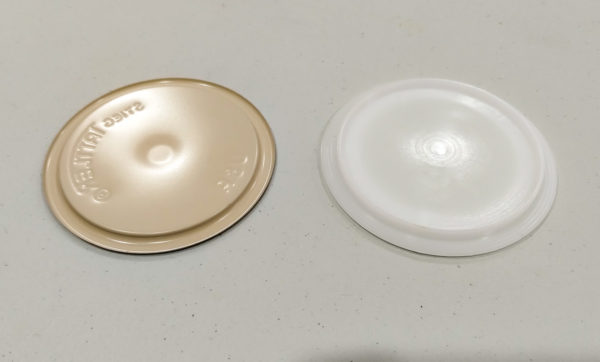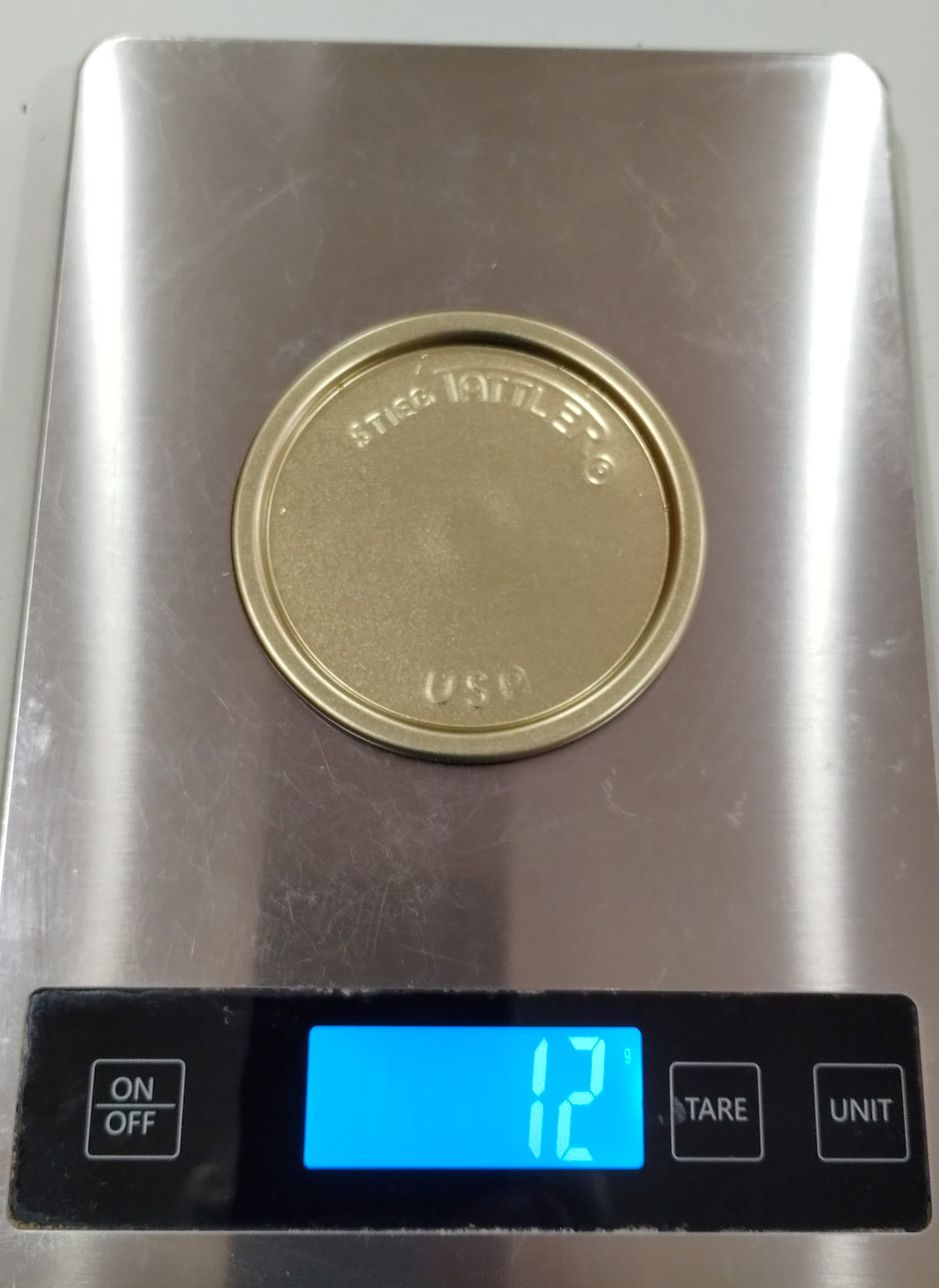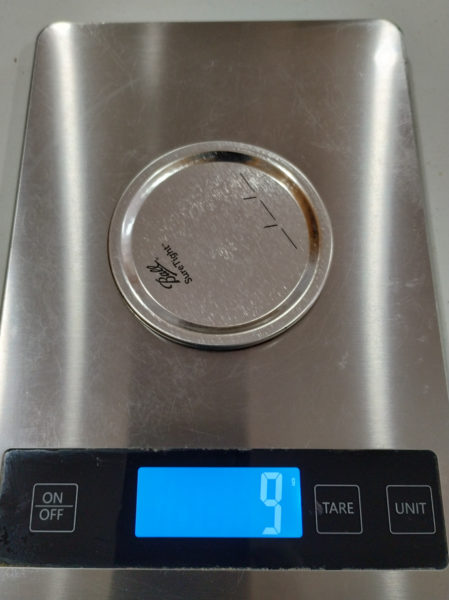I’ve used the Tattler plastic re-usable lids for quite some time. For the most part, when I open a new box of jars, I’ll use the metal lids that came with the jars. Also, when I’m making something that I know I’ll be sharing with others, I will use metal lids so I don’t have to try to get my Tattler lids back.
I was looking back on the blog to see when I started using Tattler lids and it was in 2013. I found this conversation I had written about on the blog when Vince had found a box of Tattler lids that I had never opened.

I’ve always felt that canning lids were the weak link in preserving our food. Jars and rings can be re-used over and over but if there are no lids, there is no canning. So, I will always have a good supply of Tattler re-sealable lids.
Now, Tattler has introduced a metal lid. You can read about them here. It is not re-usable, according to Tattler. I’m not sure if it’s because the USDA says metal lids are to be used one time or because the seal is so tight that it’s almost impossible to get the lid off without bending the lid.
So many canners have been complaining that they’re having problems with the other metal lids on the market. They bend, they aren’t sealing. The box says the seal is good for 18 months. So, Tattler stepped up and created lids that are more substantial (should not bend or rust on the inside) and should stay sealed for much longer than 18 months.
Of course I had to order them. As of yesterday, I’ve canned 28 quarts using them.
Here are my thoughts:
Appearance:
I’m not so concerned with appearance but thought you might like to see the lids. These are both the back side, which is where everything matters.

The lid on the right is the white re-usable lid. The lid on the left is the new metal one time use lid. You can see that with the white plastic lid, the rubber gasket simply sits on the lip. With the metal lid on the left, the gasket fits into the little “trough” which I think makes it easier getting them placed on the jar.

The above photo simply shows the gaskets in place.
Cost:
100 regular mouth with the separate gaskets – $47.00 so that’s .47 per lid/gasket.
100 regular mouth without gaskets (you already have those from re-usable lids) – $42 so that’s .42 per lid.
At Walmart, a dozen Ball regular mouth lids are 3.47 so that’s .29/lid.
That’s a pretty substantial difference in cost but keep reading.
Walmart doesn’t have any Ball wide mouth lids in stock so I can’t compare prices on that size.
Weight:
I weighed the Tattler wide mouth lid without a gasket

The Tattler metal lid, without a gasket, weighs 12 grams.

The Ball lid, with the “gasket” attached weighs 9 grams.
In my opinion, that’s a big difference in weight but does it really matter? I have no idea what components of a lid make it better than another lid but . . there’s the information for you to think about.
My Results:
I’ve now used the new lids to can 28 quarts and I have not had a failure yet. I do struggle to determine if the lids are sealed or not. I’m hoping, with experience, I’ll be able to figure it out with checking and re-checking. I normally wait 24 hours before removing the ring and checking the lid, but the first two loads, as soon as the jars felt cool, I unscrewed the ring, checked the lids, (they were all fine) and then put the rings back on for 24 hours. I think what I’m going to do is put a lid on a jar with nothing in it and not put it through the canner so it will definitely not be sealed and I can use that for comparison. Maybe that will help me.
The biggest plus for me is that I have been having a bit of problems with siphoning, where some of the liquid is sucked out of the jars. It’s not so bad when it’s potatoes with plain water in them but when it’s chicken or roast or ground beef – something that has a bit of grease. Then water in the canner is greasy; all the jars and lids are greasy. Since I can downstairs, and store the canned food downstairs, I have to bring hot, soapy water down, wipe down all the jars and lids, which sometimes means getting fresh water at least once, then taking the canner outside and scrubbing it out there. It’s a mess.
Conclusion:
I will continue to use the metal lids because of the lack of siphoning. I have tried everything to stop that – leaving a bit more head space, tightening the rings, loosening the rings, leaving the jars in the water longer to cool (though the siphoning is happening in the canner because all the “overflow” is inside the canner) and nothing has made any difference. So long as there’s no siphoning with these lids, I’m happy to pay the extra .13 per lid. If I’m running a canner full, that 14 jars at .13 extra each for a total of an extra $1.82 per load. My feeling is that for those feel that being able to can is a must, I would recommend at least getting a supply of these lids or the re-usable lids to keep on hand just in case there’s a time when the lids are hard to find. We now know it can happen!
I’m going to can some chicken today so I will use the plastic re-usable lids and see if there’s any siphoning with those. If not, then, since I have a good supply of those, I will probably use those more than the metal lids.
One more thing: Most everything that I freeze dry, I put into jars and vacuum seal. I cannot use the plastic lids to vacuum seal . . they just don’t work for me. I will try the metal lids/gaskets and see if they work. I will report back as soon as I vacuum seal something and then we’ll know if the Tattler metal lids work for vacuum sealing. Otherwise, my only option for vacuum sealing jars will be Ball (or similar brand) lids.

Ginger S says
Judy, I was wondering how long you can have the ball lids before you use them. Does the age affect the seal? Thinking about the rubber gasket.
Tee says
You and I have talked about siphoning and when I called Nesco, they didn’t have much to offer, other than to let it cool down over a long period, before opening the canner. That hasn’t helped. I agree with you on the cost, if it reduces siphoning, it is worth it. At a certain point, the jar is no longer safe if there is too much siphoning and your work is wasted. Thanks for the head’s up!
judy.blog@gmail.com says
I don’t get them saying let it cool down because when I open the canner, the siphoning has already happened. I’ve only processed 28 quarts so I can’t say that solved 100% of the siphoning problem but there was none in those two batches. Both were done in the big pressure canner and I’ve had problems in there, as well as the Nesco.
patti says
since i reuse my metal lids for vacuum sealing, they often have numerous things written then scratched out on the tops. now that i’m using
the tattler plastic ones more i can’t write on those. how do most people deal with this? i’ve seen cute lables but am much more down to earth so they seem frivolous to me.
judy.blog@gmail.com says
I use a Sharpie and write on the jar. It comes off easily when washed. I’ve also had good luck with paint pens on the white Tattler lids. It comes off easily when scrubbed.
Linda in NE says
I’ve canned quite a bit this year and the only sealing failures have been Ball or Kerr lids (and only two of those). My preference is the lids I get from Lehman’s and since the ones that were backordered for a year arrived I’ve mostly used them. Funny thing is that as hard as lids were to find in 2020 this year the local store got a bunch in and it seems like nobody was buying them. They still have a bunch.
judy.blog@gmail.com says
I’ve heard good things about the Lehman’s lids.